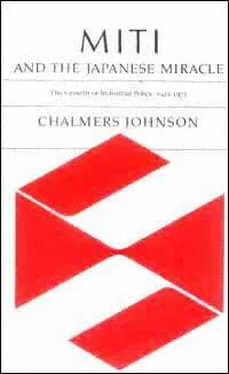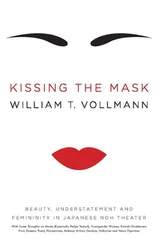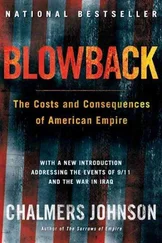Chalmers Johnson - MITI and the Japanese miracle
Здесь есть возможность читать онлайн «Chalmers Johnson - MITI and the Japanese miracle» весь текст электронной книги совершенно бесплатно (целиком полную версию без сокращений). В некоторых случаях можно слушать аудио, скачать через торрент в формате fb2 и присутствует краткое содержание. Год выпуска: 2007, Издательство: Stanford University Press, Жанр: Старинная литература, на английском языке. Описание произведения, (предисловие) а так же отзывы посетителей доступны на портале библиотеки ЛибКат.
- Название:MITI and the Japanese miracle
- Автор:
- Издательство:Stanford University Press
- Жанр:
- Год:2007
- ISBN:нет данных
- Рейтинг книги:3 / 5. Голосов: 1
-
Избранное:Добавить в избранное
- Отзывы:
-
Ваша оценка:
- 60
- 1
- 2
- 3
- 4
- 5
MITI and the Japanese miracle: краткое содержание, описание и аннотация
Предлагаем к чтению аннотацию, описание, краткое содержание или предисловие (зависит от того, что написал сам автор книги «MITI and the Japanese miracle»). Если вы не нашли необходимую информацию о книге — напишите в комментариях, мы постараемся отыскать её.
MITI and the Japanese miracle — читать онлайн бесплатно полную книгу (весь текст) целиком
Ниже представлен текст книги, разбитый по страницам. Система сохранения места последней прочитанной страницы, позволяет с удобством читать онлайн бесплатно книгу «MITI and the Japanese miracle», без необходимости каждый раз заново искать на чём Вы остановились. Поставьте закладку, и сможете в любой момент перейти на страницу, на которой закончили чтение.
Интервал:
Закладка:
In essence Morozumi retained both the International Trade and Trade Promotion bureaus but renamed them; changed the name of the Enterprises Bureau to the Industrial Policy Bureau and gave it new sections for Industrial Structure and Business Behavior; merged the old Light and Heavy Industries bureaus into a new Basic Industries Bureau (metals and chemicals combined); created a new Machinery and Information Industries Bureau that put electronics, computers, automobiles, and general machinery under one administration (we shall return to this grouping later); transformed the old Textiles Bureau into the Consumer Goods Industries Bureau; and set up a new external agency, the Natural Resources and Energy Agency (NREA), which combined the administration of petroleum, coal, energy conservation, and public utilities (including nuclear power generation)
Page 297
into one powerful unit. (Appendix B includes a chart of MITI's "new structure," or "face lift," as some critical journalists put it.)
40
Morozumi retired on the day the new structure was enacted and turned over its implementation to Yamashita Eimei (class of 1943, former first secretary in the Canadian embassy, deputy director of the Heavy Industries Bureau, and chief of the Chemical, International Trade, and Enterprises bureaus). On October 6, 1973, the "Fourth Middle Eastern War" (as the Japanese call it) erupted. Ten days later six countries of the Organization of Petroleum Exporting Countries raised their oil prices by 21 percent, and on October 20 six Middle Eastern nations suspended shipments of oil to nations supporting Israel. The "oil shock"a considerably more important event than what the Japanese press had called the "Nixon shocks"hit Japan and the world with stunning force. On November 16, 1973, the cabinet enacted its "Emergency Petroleum Countermeasures Policy," which ordered crash conservation programs; and Japanese political leaders, including MITI Minister Nakasone, set out on trips to the Middle East to try to win friends among nations they had not paid much attention to in the past. Japan was the world's largest petroleum importer and totally dependent on the Middle East. (One of the projects that Nakasone agreed to build in the area in order to cement relations was a $3 billion petrochemical complex at Bandar ShahpurBandar Khomeini after the 1979 revolutionin Iran. Ironically enough, Vice-Minister Yamashita Eimei, who became an executive of the Mitsui Trading Company after his retirement, ended up being in charge of building it. Cost overruns, the turmoil of the revolution, and damage done during the war between Iran and Iraq may have turned it into one of the most expensive foreign-aid efforts the Japanese have ever undertaken.)
41
The significance of the oil shock for purposes of this study lies in the fact that it once again reminded the Japanese people that they need their official bureaucracy. The country had had a governmental energy policy in one form or another ever since the Meiji Restoration, and the energy problems of the 1970's provided MITI, in the words of the
Mainichi
, with a "once in a lifetime opportunity" to regain its previous authoritya challenge that it met with great skill and ingenuity.
42
The ministry's immediate problem was the impact of the oil crisis on the already "crazy" prices. First heating oil began to rise in price and then to disappear altogether from the market. Then toilet paper and next household detergents became scarce. The public became
Page 298
convinced that industrial cartels were using the crisis in order to make huge profits. An atmosphere similar to that at the time of the rice riots gripped the country. Minister Nakasone set up a command post inside MITI that he manned himself with his bureau chiefs and his chiefs of the Paper and Pulp Industry Section in the Consumer Goods Industries Bureau (in charge of toilet paper) and the Chemical Products Section in the Basic Industries Bureau (in charge of detergent). When the taxi drivers went on strike because of a shortage of liquefied petroleum gas, or housewives rioted in Osaka because of a shortage of kerosene, or long lines were discovered in front of supermarkets that allegedly had toilet paper for sale, the MITI leaders tried to send emergency shipments to calm the panic buying. Old industrial policy bureaucrats reared on the slogan that "steel is the rice of industry" now found themselves preoccupied with consumer goods and irate housewives. The leaders of the ministry, who had begun their careers during the occupation, said that it reminded them of the days of the Economic Stabilization Board, when MCI exercised control over all commodities.
43
Out of this confusion came two new laws: the Emergency Measures Law for the Stabilization of the People's Livelihood (Kokumin Seikatsu Antei Kinkyu* Sochi Ho*, number 121 of December 22, 1973) and the Petroleum Supply and Demand Normalization Law (Sekiyu Jukyu* Tekiseika Ho, number 122, also of December 22). They gave MITI broad powers to demand reports from wholesalers and retailers on their supplies, to establish standard prices for designated commodities, to draw up plans for the supply of consumer products, and to fine violators. Nakamura compares the petroleum law specifically with Yoshino's trade control law of September 1937, and Kakuma sees in both 1973 laws a return to at least the time of Sahashi's Special Measures Law.
44
In essence the new laws legalized MITI's administrative guidance and formally recognized that administrative guidance was in the national interest. Neither law created a "third control era," as some feared they would, but they did begin to tip the balance in Japan from "self-control" back toward "state control."
And yet during 1973, with the country experiencing a 29 percent inflation rate, the question of whether MITI's administrative guidance served the national interest or only the interests of big business remained intensely controversial. It was the Fair Trade Commission that placed this question squarely in the limelight. On October 24, 1972, Prime Minister Tanaka had named a most unusual and independent former bureaucrat, Takahashi Toshihide (chief of the Ministry of Finance's Banking Bureau from April 1963 to June 1965, the period dur-
Page 299
ing which the bureau was engaged in constant conflict with Sahashi over the Special Measures Law), as chairman of the Fair Trade Commission. Takahashi simply believed that it was his job to defend the Antimonopoly Law, even though it had been widely ignored in recent years. He was also convinced that the economic events of 1972 and 1973 were related to this flouting of the Antimonopoly Law.
Takahashi could have chosen any of several industries to make his point (steel, for example), but because of the oil crisis he chose the petroleum refining and distribution industry. On November 27, 1973, officials of the Fair Trade Commission raided the offices and demanded to see the books of the Petroleum Association of Japan and of twelve petroleum companies. According to the FTC, ''The on-the-spot inspection was made to investigate a report that the oil companies raised the prices of their products and restricted supplies under the initiative of the association."
45
On February 19, 1974, based on the documents his inspectors had collected, Takahashi charged the association and the companies with operating an illegal price cartel and turned the case over to the Tokyo High Public Prosecutor's Office. This was a sensational developmentTakahashi's picture was on the cover of most national magazines that weekand it became even more sensational when the petroleum companies replied that anything they had done in concert had been in accordance with MITI's administrative guidance.
The prosecutors called in numerous MITI officials, including Iizuka Shiro*, then director of the Basic Industries Bureau and formerly in charge of administrative guidance over the petroleum industry, and questioned them closely about their intentions in administrative guidance, what role the Petroleum Association played in it, and numerous other questions MITI was not pleased to have aired in the newspapers. Vice-Minister Yamashita met the press and angrily denied that MITI condoned illegal acts; he argued that the oil companies' prices would have gone up twice as much if the ministry's administrative guidance had not prevented it. But MITI was definitely on the defensive, and its defense was not helped when, on April 16, 1974, the
Читать дальшеИнтервал:
Закладка:
Похожие книги на «MITI and the Japanese miracle»
Представляем Вашему вниманию похожие книги на «MITI and the Japanese miracle» списком для выбора. Мы отобрали схожую по названию и смыслу литературу в надежде предоставить читателям больше вариантов отыскать новые, интересные, ещё непрочитанные произведения.
Обсуждение, отзывы о книге «MITI and the Japanese miracle» и просто собственные мнения читателей. Оставьте ваши комментарии, напишите, что Вы думаете о произведении, его смысле или главных героях. Укажите что конкретно понравилось, а что нет, и почему Вы так считаете.












